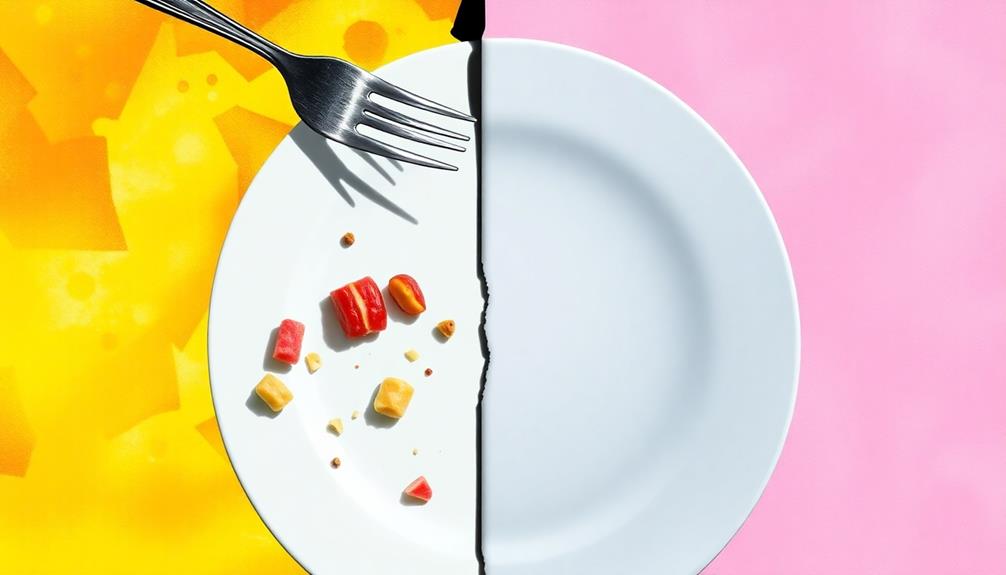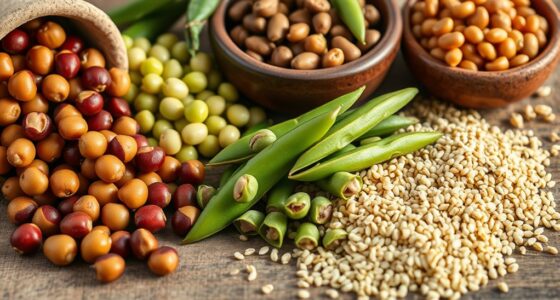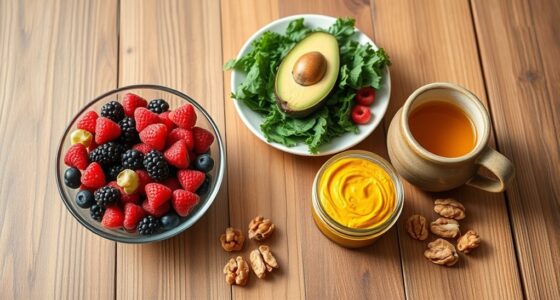Clean Plate Syndrome can entrap you in a cycle of overeating and guilt. It's rooted in psychological and cultural influences, pushing you to finish every bite, often regardless of hunger. You might feel compelled to clean your plate due to societal expectations or childhood lessons about avoiding waste. This habit can lead to health issues, including obesity and metabolic problems, as you ignore your body's signals of fullness. However, you can regain control through mindful eating practices. By understanding these patterns, you'll uncover ways to break free from this mindset and foster healthier habits.
Key Takeaways
- Clean Plate Syndrome stems from psychological triggers, leading to an overwhelming desire to finish everything on the plate, regardless of hunger levels.
- Cultural influences often reinforce the habit of cleaning plates, linking food consumption to social acceptance and family dynamics.
- Overeating due to Clean Plate Syndrome can result in cognitive dissonance, where individuals downplay the health risks associated with excessive food consumption.
- Ignoring satiety signals fosters unhealthy eating patterns, increasing the likelihood of obesity and chronic diseases over time.
- Mindful eating practices can counteract Clean Plate Syndrome, promoting awareness of hunger and fullness cues to prevent overeating.
Understanding Clean Plate Syndrome

Understanding Clean Plate Syndrome starts with recognizing its psychological roots. This phenomenon compels you to finish every bite on your plate, often resulting in excessive food consumption and potential weight gain. Many adults unknowingly consume about 92% of the food served, showcasing how portion sizes markedly influence your eating behavior.
In cultures with rich culinary traditions, such as Chinese cuisine, where dishes like Red-Braised Pork Belly are often served in generous portions, the pressure to clean your plate can be even more pronounced.
If you were raised to clean your plate, you might've developed unhealthy habits that persist into adulthood. For instance, you may request larger portions when unsupervised, which can lead to overeating and obesity later in life. The Clean Plate Club mentality often stems from family norms and social pressures that prioritize finishing meals, making it harder for you to tune into your hunger cues.
Moreover, research indicates that the size of your plate can dramatically impact how much you eat. Using larger plates often leads you to serve yourself 25% more food, reinforcing the connection between plate size and overeating.
Understanding these factors can help you reassess your relationship with food and portion sizes, allowing for healthier eating habits and a more mindful approach to meals.
Psychological Triggers for Overeating

Psychological triggers play an essential role in driving overeating habits. You may find that certain situations or thoughts prompt you to consume more than necessary, often linked to the clean plate phenomenon. For example, enjoying a hearty dish like braised beef in Barolo wine can create a desire to finish every last bite, reinforcing the need to clean your plate.
When you're conditioned to finish every bite, it can lead to an increased food intake, making it hard to stop even when you're full. Here are some common psychological triggers:
- Serving size perception: You're more likely to overeat if you're given larger portions, as your brain equates bigger plates with more food.
- Last bite temptation: The desire for that final bite can be overwhelming, making you want to finish everything on your plate.
- Cognitive dissonance: You might downplay the health risks of overeating, convincing yourself it's okay to indulge.
- Imagined satisfaction: Visualizing the pleasure of finishing leftovers can make you more inclined to clean your plate.
If you aim to reduce overeating, consider using smaller plates. This simple change can help you manage portion sizes and resist the urge to overeat, allowing you to enjoy food without the psychological burden of finishing everything.
Cultural Influences on Eating Behavior

Cultural influences heavily shape how you approach eating and the expectations surrounding food consumption. Many cultural traditions dictate meal structures and portion sizes, often emphasizing the importance of finishing everything on your plate. This clean plate habit can lead to overeating behaviors, as you might feel pressured to consume more than your body needs.
For example, in Brazilian culture, the rich and diverse culinary landscape often promotes the enjoyment of large portions, making it easy to feel obligated to finish every dish, such as a hearty Caldeirada.
During celebratory events, an abundance of food reinforces societal expectations to clean your plate, linking food consumption to social acceptance. In some cultures, historical food scarcity has ingrained deep-rooted habits around avoiding waste, making it difficult to break away from the mindset of finishing every last bite. This dynamic can contribute to overconsumption, as individuals may feel compelled to eat beyond their needs to adhere to these norms. Additionally, the psychological effects of clean eating often intertwine with these cultural pressures, creating a complex relationship between food, guilt, and self-discipline. Over time, this can blur the line between mindful eating and an unhealthy obsession with food rituals.
Family dynamics also play a significant role; practices like food pushing during meals can further entrench the expectation to clean your plate.
Additionally, media portrayals of food and eating shape societal ideals, often glorifying abundance and enjoyment. As a result, you may find yourself more inclined to overconsume in an effort to align with these cultural ideals.
Understanding these influences can help you navigate your eating behaviors and challenge the societal expectations that drive them.
Health Consequences of Overeating

Overeating, often a consequence of the Clean Plate Syndrome, can lead to serious health issues that extend far beyond just weight gain. For instance, indulging in rich and flavorful foods, like Mushroom Masala, can make it even more challenging to listen to your body's natural hunger cues. This pattern not only disrupts your body's natural hunger cues but can also result in long-term health complications.
When you prioritize consumption closure—finishing your plate over listening to your body—you risk developing harmful habits.
The health consequences of overeating include:
- Increased risk of obesity, which affects metabolic health.
- Higher likelihood of chronic diseases such as diabetes and heart disease.
- Ignoring satiety signals, leading to continuous unhealthy eating patterns.
- Justifying excessive portions in social settings, fueling cognitive dissonance.
Studies show that even small changes in portion sizes can lead you to consume up to 25% more food. By conditioning yourself to finish everything on your plate, you may find it increasingly difficult to prevent weight gain.
Understanding these health risks associated with Clean Plate Syndrome is the first step towards making healthier choices. By recognizing the impact of overeating, you empower yourself to break the cycle and prioritize your well-being.
Strategies for Mindful Eating

Mindful eating is a powerful tool to combat the habits formed by Clean Plate Syndrome. By slowing down and savoring each bite, you can better recognize your hunger and fullness cues. This practice not only enhances your meal experience but also greatly reduces the likelihood of overeating.
For instance, enjoying seasonal dishes like Nettle and Potato Soup can help you appreciate fresh ingredients and their flavors. Before diving into your meal, take a moment to express gratitude for your food. This simple act can elevate your enjoyment and satisfaction, making you more conscious of what you consume.
Another effective strategy is to put down your utensils between bites. This encourages you to focus on the taste and texture of your food, allowing you to connect more deeply with your meal.
Frequently Asked Questions
What Are the Psychological Effects of Food Shaming?
Food shaming can lead to feelings of guilt and anxiety around eating. You might find yourself justifying unhealthy choices or overeating as a response to societal pressures, which can ultimately harm your relationship with food.
What Is the Clean Plate Club Mentality?
Did you know nearly all adults eat 92% of the food served to them? The Clean Plate Club mentality pushes you to finish everything on your plate, often leading to overeating and reinforcing unhealthy habits.
What Are the Psychological Effects of Starvation?
Starvation can lead to increased anxiety, depression, and irritability. You might struggle with cognitive functions like memory and decision-making, while also developing an unhealthy fixation on food, leading to emotional imbalances and binge-eating behaviors.
How to Overcome Clean Plate Syndrome?
To overcome clean plate syndrome, focus on mindful eating. Use smaller plates, take home leftovers, and listen to your body's hunger cues. Create a supportive environment where you feel comfortable leaving food uneaten if you're full.
Conclusion
In the intricate dance of dining, recognizing clean plate syndrome is your first step toward freedom. It's like shedding a heavy cloak; once you embrace mindful eating, you'll savor each bite rather than rush to finish. Break the cycle of societal pressures and listen to your body's whispers. By doing so, you'll transform meals from a race into a celebration, allowing joy and health to fill your plate rather than guilt and excess.










